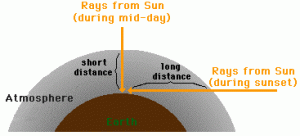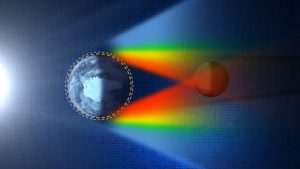Why moon looks red? What is blood moon? Blood red moon – really?
• admin@sciloo.com
You would have seen the moon in orangish/reddish colour many times but may have missed the interesting questions – why the moon is behaving this way? What is causing this?

This question is usually asked by our curious children and we are unable to answer it. We tell them we will explain it later that probably doesn’t come usually. This happens because the products of their curiosity keep on piling up.
The names “Red moon” or “Red blood moon” is given to the moon during the lunar eclipse because it is having the darker red colour as compared to other situations (the horizon, view through dust, etc.).
There are 3 possibilities when this colour change happens
- Near the horizon
- by dust/smoke particles
- Lunar eclipse
Please follow the video below for high-level details on each and keep on reading the post for the detailed explanation.
Earth’s Atmosphere
Earth’s atmosphere plays a big role in this phenomenon. Earth’s atmosphere is spread around the Earth and bound to it by gravity, that is the reason it is spherical. Light photons from the distant objects cross our atmosphere and this light get scattered by the particles (air, atom, molecules, etc.). By the time the light from the moon enters your eyes, the blue, green, shorter range visible light spectrum would have been already scattered [1,2] away by the different particles and molecules. Only yellow, orange, or red penetrates because of their longer wavelengths.
So, these objects appear reddish because the reddish (longer) wavelengths from these objects penetrate the atmosphere better than the bluish light (shorter wavelength photons).
This phenomenon may not be visible from space because of the lack of the atmosphere but on another planet, you can find similar results but with different intensity due to atmospheric thickness and composition.
Horizon and the distance
This phenomenon is more predominant near the horizon if you have noticed a regular pattern. Light has to cross through the longer path of atmosphere before entering your eyes when the Sun/Moon is on the horizon. More blue/short wavelengths of light are scattered from Sunlight/Moonlight when the Sun/Moon is on the horizon than any other positions especially overhead. Sun/Moon look reddish/orangish when it is rising or setting because light is travelling a greater length in the atmosphere.

Dust/Smoke
Sometimes the moon can appear orangish/yellowish even when it’s overhead or nearby positions. Dust, smoke, or pollution in the atmosphere are responsible for the colour change. They scatter the light in the similar manner as it is scattered over a long distance (more particles) when the moon is near the horizon.
Eclipse
During the lunar eclipse, the light is blocked by earth but still, some light from the top and bottom of the earth reaches to the moon and this light cross earth’s atmosphere, giving birth to the same results. This appears more reddish and that is the reason it is called blood moon sometimes. Please check the following picture and video given in this post for more details.

[1] Scattering of light – http://www.atmo.arizona.edu/students/courselinks/spring08/atmo336s1/courses/fall13/atmo170a1s3/1S1P_stuff/1S1P.html
[2] Rayleigh scattering – http://hyperphysics.phy-astr.gsu.edu/hbase/atmos/blusky.html